Today we are having a look at a new composition course called Cinematic Music Creation. Hosted by Christopher Siu, this comprehensive course promises to cover multiple topics, step by step, from music theory, composition techniques, and orchestration, all the way up to mixing and mastering.
Over the last few weeks, I’ve had the chance to enroll in this course and will now share my thoughts and takeaways from it.
OVERVIEW
Cinematic Music Creation is tutored by Christopher Siu, a classically trained pianist with a degree from the University of Toronto, Canada. He has been teaching online for a few years now, particularly piano lessons, music theory, and songwriting techniques. He also produces regular videos on his Youtube channel covering these topics, and more.
After releasing a songwriting-oriented music theory course in 2019, Christopher then decided to create a course dedicated to cinematic music. As a fan of composer Alan Menken (Aladdin, Beauty and the Beast, Tangled) and Disney music in general, he has also been producing many cinematic works in this particular fantasy/family adventure genre, as demonstrated by his demo reel:
The course is divided into several modules :
- Your mindset
- What you need
- Music Theory Fundamentals
- Principles of Orchestration
- Composition and Musical Development
- Arrangement and Orchestration
- Mixing and Mastering
- Releasing your Music
Enrolling also gives us access to a personal track review and to a private Facebook group where you can keep in touch with other members and ask for feedback on your work.
It is also important to note that it is possible to buy some of the main modules separately if you are only interested in a specific topic. More on this a bit later.
THE MODULES
The course starts with a brief analysis exercise of one of Christopher’s tracks. This serves as a good introduction to “critical listening”, and is a good test for our knowledge of instrumentation and basic harmony.
You will also find that throughout the chapters some PDF files are provided as support, which are either additional notes on a topic or written extracts from the lessons themselves.
When choosing a course of this type, meeting expectations is essential, so I will give you a clear idea of what each chapter contains and their respective goals.
Your Mindset & What you Need
In these first few videos, Christopher starts by giving us general tips for setting up a good working environment. They are presented in a similar form as a PowerPoint presentation, with slides used to getting the points across. Christopher teaches us various good habits to be used, and talks about problematic areas, namely how to deal with procrastination, time management, and proper goal-setting in order to stay positive about the whole experience, despite obstacles that will inevitably be encountered.
That point particularly is important for upcoming composers, and one can clearly see that Christopher’s previous teaching experience shines here, as he already dealt with various student responses in his music tutoring.
Following this, the course offers a couple of videos about the hardware and software needed to be able to compose on a computer nowadays. These include basic information about DAWs, controllers, followed by a presentation of starter music libraries and their respective developers. Nothing revolutionary here, but this information will be useful for musicians who are new to the field, or didn’t have the opportunity to use a computer for music before.
This module is just an introduction to the course and as such is relatively short, with approximately an hour of video combined.
Music Theory Fundamentals
This chapter is way larger than the previous one and features an ambitious program. As you can see in the screenshot below, Christopher starts from the absolute basics of music theory and then goes into pretty advanced topics such as modulation. There is quite a lot to cover, and as a result, the module is comprised of 13 videos, for a total of just over 4 hours.
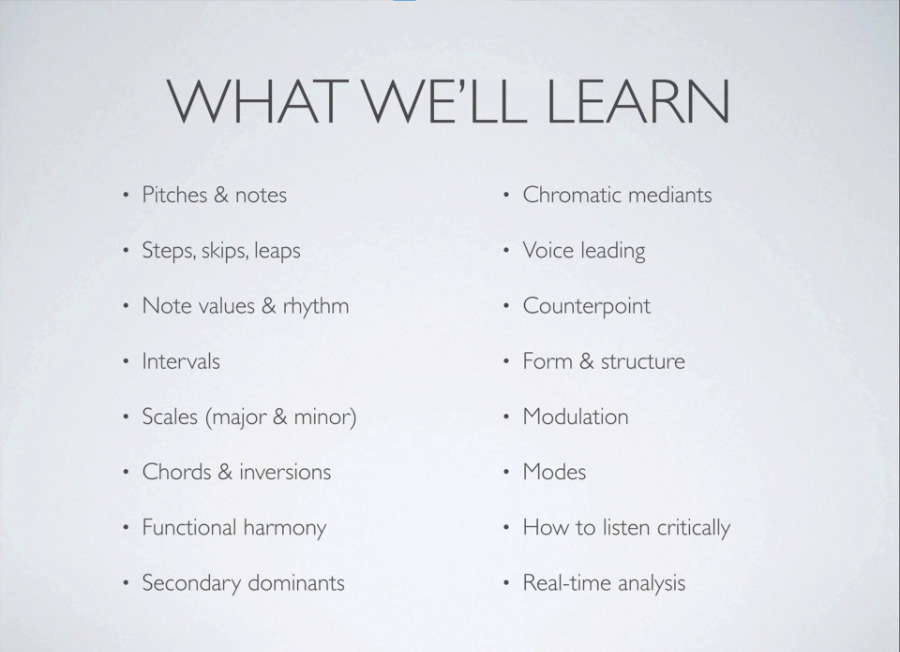
Starting with the very basics, and by using simple terms, Christopher introduces us to the ideas of notes, steps, scales, octaves, and time signatures. He then explains the concept of building a major/minor scale and the idea of parallel and relative scales. There is also a video explaining how to play scales on a piano, using the proper fingering technique – a nice addition coming from a piano teacher!
Next, Christopher talks about the different intervals and their associated moods. The concept of chords and inversions is then taught, along with the circle of fifths. Then we continue our journey into harmony, looking at functional harmony, along with examples of cadences and typical chord progressions.
The pace picks up a little after this as the next video is about spicing up chord progressions. In this one, Christopher starts to introduce us to more advanced harmony concepts, such as secondary dominants, chromatic mediants, and modal mixture/modal borrowing. The next videos are then about voice leading (a topic that will be talked about again in the composition videos), counterpoint species and forms, to finally end with modulation and modes.
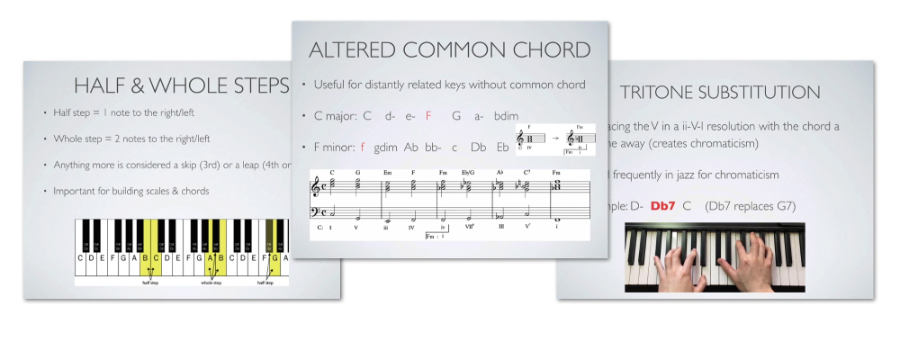
The lessons are well organized and Christopher has a gentle way of explaining concepts. At the bottom of each video, there are a couple of exercises in order to practice what was taught. Some of the videos are accompanied by footage of Christopher at his piano demonstrating some concepts. I do, however, feel that for someone with a complete lack of music theory knowledge, the second half of this module might feel a bit daunting at first. It might be better to really exercise and repeat the concepts taught in the first half before moving on.
Principles of Orchestration
This chapter starts with reviewing the harmonic series, a concept that will be crucial later on when we get to arranging. Then we dive into the various orchestral sections: strings, woodwinds, brass, and percussion. Christopher does a good job at walking us through them, describing the instruments’ capabilities and range, their qualities, sometimes even their weaknesses, in order to better understand how to use them, and which one could better fit certain roles.
The information here is somewhat similar to what you could find in popular orchestration books, albeit in a more condensed format. The included PDF notes here are particularly useful, as there is a lot of information you will need to go back to in your own composition process later.
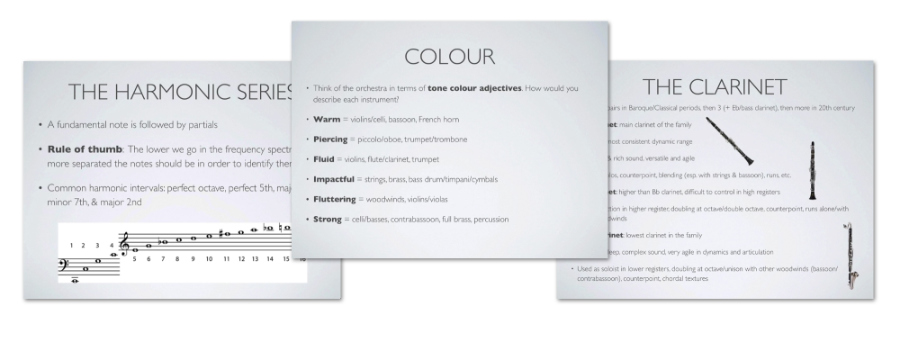
Each orchestral section has its dedicated video, bringing the total runtime of this chapter to more than 3 1/2 hours. There are also a few videos at the end of this chapter covering tips on how to use different microphones, and basic orchestration advice.
Composition and Musical Development
In this chapter, we finally get into the more practical aspects of music production. Christopher starts by giving us good practices to follow when approaching compositions. One of his key takeaways here is to focus on the fundamentals: the melody, the harmony, the rhythm, and the texture.
There are other very interesting topics being discussed later, like how to develop musical ideas, how to write a melody from a given chord progression, and why certain notes in the melody will have a particular effect on the feel of the track.
Christopher then discusses the concept of writing a B section (a bridge) using a simple lullaby, which is clever, as the simple nature of the piece allows us to focus only on the melodic and harmonical elements to be added. He uses the program Synthesia for this, which allows a clear display of the notes played.
In complement to this, you will also find a short analysis on how John Williams develops a B section and a look at his E.T. main theme.
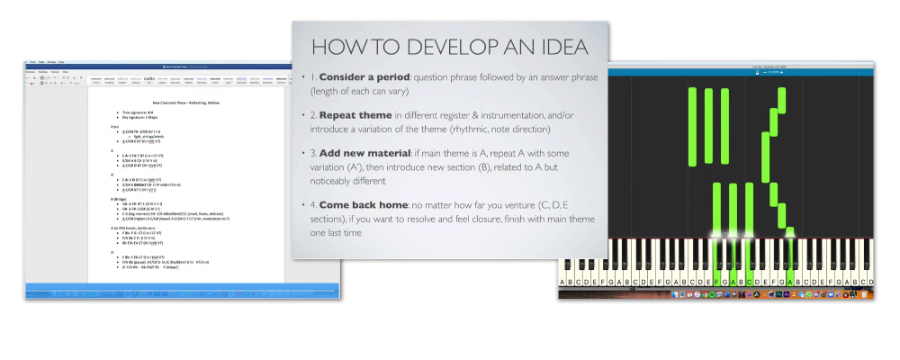
Finally, we have a look at how Christopher creates a track from scratch, initially in the form of a text draft. As he writes down his notes, we focus only on choices of harmony and melody. These are the foundation of the track that will be arranged and orchestrated in the next chapter.
The track is very lyrical and would fit well in a Disney/Fantasy-style environment. There is quite a lot to take away from this and once again, Christopher does a good job at explaining his choices. All in all this chapter is just short of 3 hours long.
Arrangement and Orchestration
In the Arrangement and Orchestration chapter Christopher continues to work on the Disney-style track he drafted just before, but this time using a DAW.
It all starts by having a look at working with templates, how to create one, and the pros and cons of using it. We then have a quick review of basic mockup techniques, like MIDI CC modulation and expression control.
We then go into arranging the track itself. The videos are divided by following the track structure itself (Intro, A1, A2, B, Ending). In each of the comprehensive video lessons, Christopher explains all his choices in terms of arrangement and orchestration. Following the melody-focused style of the track, the arrangement mainly features strings, woodwinds, and brass instruments. This is the track that is getting produced over the next chapters:
An excellent thing here is that the videos are not edited which gives a beginning composer an honest look behind the curtain. As a student, you learn that some theoretical decisions are not always the best fit in practical implementation. Also, Christopher shows, on purpose, some arranging alternatives – let’s say how doubling a fifth against doubling a third sounds – and we get to see which impact this could have on the track.
In these video lessons, Christopher references his previous draft quite often, so you get to easily follow what he’s doing, which chord progression he is currently working on, and so on.
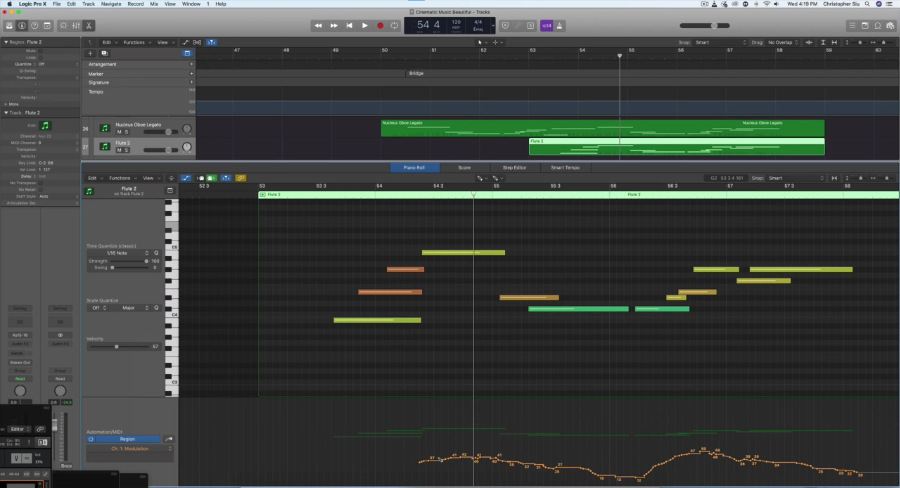
On the whole, this chapter provides a solid series of over-the-shoulder composing videos, and a very comprehensive one too, as the total running time is close to 8 hours.
Mixing & Mastering
In this chapter, Christopher shows us his mixing workflow. He first gives us a complete overview of his own method, which is then divided into several steps.
First, we get to see how he organizes his mixing template using different group tracks. Then Christopher shows us the different EQ tweaks he applies to his tracks. Sometimes they are used to clean up individual tracks, sometimes to avoid muddying up the low end, and again sometimes to slightly boost the high-end on leading parts. As before, each choice he makes is explained in detail.
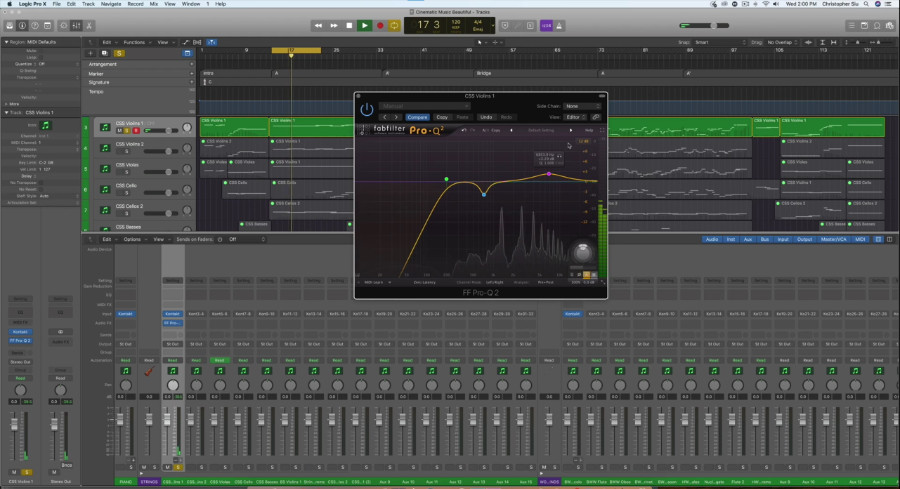
The next step is to go back to our mix and try to achieve a volume balance that works for the majority of the track. The way Christopher approaches this is by resetting all the faders to zero, then focusing on the leading elements in the climax, and putting their faders back up one by one, to an appropriate level. He then goes on to the other instruments by order of importance in the climax.
The next video is about top-down mixing, a method that is used a lot in pop music, too. Christopher shows us how to work on the mix bus first, applying subtle EQ and compression, and only then work on the individual groups and tracks, if required. It is nice to see this method being taught here in a cinematic context and it indeed looks like a big time saver if used correctly!
The last two steps are volume automation and mastering. The goal of automation is to fine-tune what we did earlier and Christopher shows us in detail how he applies these tweaks. He then shows us his mastering chain, which he keeps very simple. Again, he justifies his choices very well by explaining their impact on the overall piece of music.
The chapter ends with a download link to the stems and MIDI files of the project. This way you can put theory into practice and have your own go at mixing and mastering. The total running time is about 3 hours.
Bonus Chapters
Towards the end of the course, you will find a number of bonus videos covering various topics. These include how to make money in music, how to self-assess your work, as well as a couple of thoughts on particular chord progressions.
One video I found particularly useful is about how to write music in different styles. Christopher approaches this subject very thoroughly, showing us the relevant theoretical assets we could use for each style.
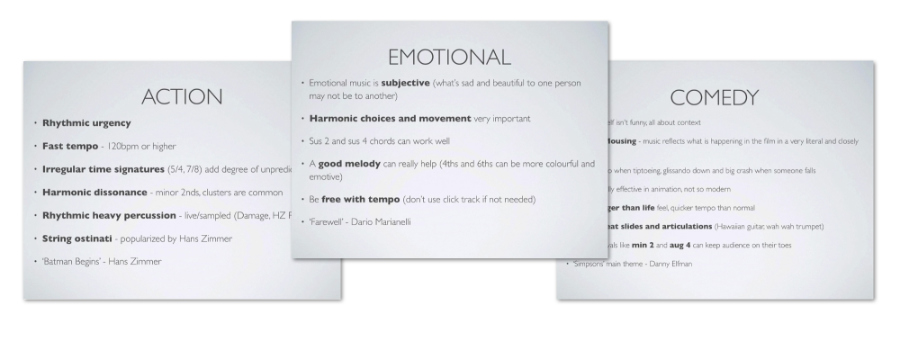
Another highlight is watching Christopher creating a heroic track from a simple voice memo he sang into his phone. From a simple melody, he explains how he goes about choosing chords that would fit, which rhythmic elements he would use, and ends up creating a full theme.
These bonus videos run for a total of 1 1/2 hours.
CONCLUSION
All in all, Cinematic Music Creation is a very comprehensive course, totaling 25 hours of video lessons. The content is easily accessible and Christopher, due to his great knowledge of music theory, does an awesome job of explaining the reasons behind his decisions.
Beyond the first chapters on theory, the course has a lot of practical implications, and will surely inspire many new tracks from students.
At $497, the course is in the average range of prices for a course that covers such grounds, especially if we take into account that a personal track review is included, and the fact that it covers a specific music genre, not always talked about in other courses.
Another thing to keep in mind for people who already have a bit of knowledge regarding cinematic music production is that the main modules are also purchasable individually, for $97 each, which provides excellent value in my opinion.
Pros
- Clear and logical teaching style
- Great compositional insights based on music theory throughout the chapters
- Hours of over-the-shoulder orchestrating & arranging
- Personal track review included in the purchase price
Cons
- Powerpoint-style lecturing may not be everyone’s cup of tea
- One more video bridging the gap between basics and advanced notions in the theory chapter could be beneficial for people with no formal music education
RECOMMENDED: 8/10
The Cinematic Music Creation course by Christopher Siu is available through the online learning platform Podia for $497. Individual chapters can be purchased at $97 each.
Update: The Cinematic Course now comes in two different tiers, the so-called Basic Tier and Inner Access Tier. The Basic Tier, which includes all the familiar content as well as two new models is available for $497. The Inner Access Tier includes all the aforementioned plus an exclusive 90-minute coaching call with Christopher himself. The Inner Access Tier is offered for $697.


0 comments on “Cinematic Music Creation (Course Review)”